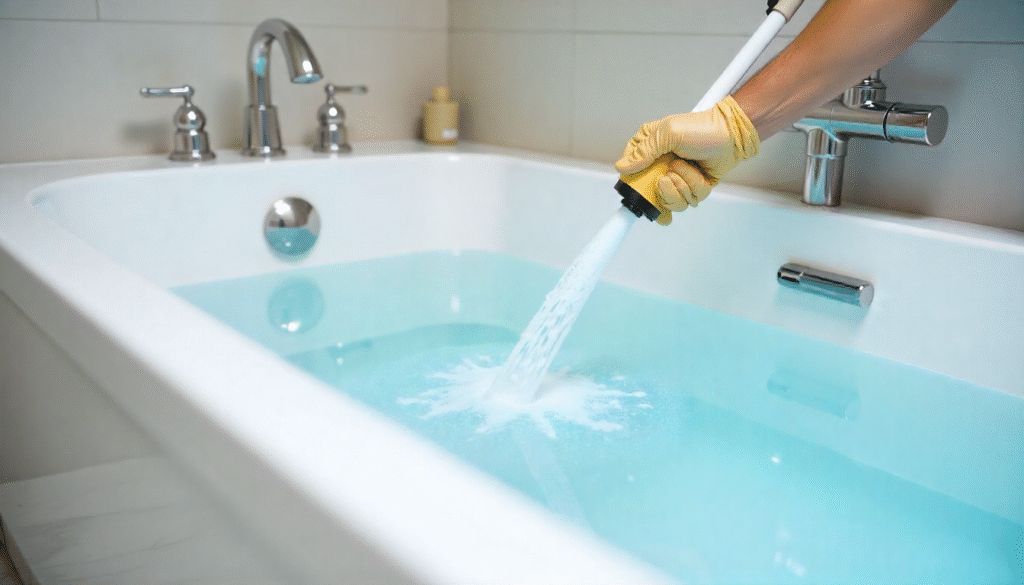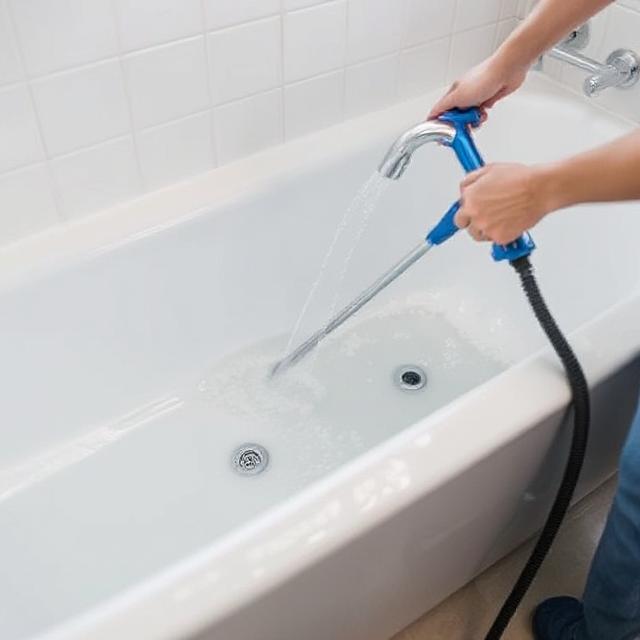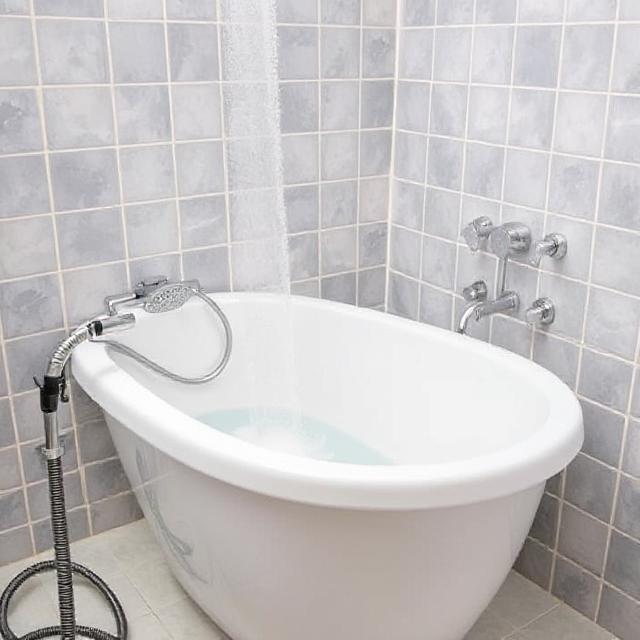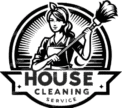
Introduction:
Clean Bathtub Jets the right way to keep your jetted tub fresh, hygienic, and running smoothly. Over time, soap residue, body oils, and bacteria build up inside the jets, causing unpleasant odors and reduced water pressure. Regular cleaning not only improves performance but also ensures a relaxing, spa-like experience every time you bathe.
Table of Contents
Why Cleaning Bathtub Jets Matters
A jetted bathtub is designed for relaxation — but over time, those soothing jets can become breeding grounds for bacteria, mould, and grime. Every time you run your whirlpool or spa tub, water and soap residue flow through tiny jet lines. If you don’t clean them regularly, residue builds up and can cause unpleasant smells, black flakes in the water, and even clogged jets.
Regular cleaning of jets in a bathtub helps maintain both your health and the performance of your tub. Here’s why it’s so important:

1. Prevents Bacteria and Mould Growth
Warm, damp jet lines are the perfect environment for bacteria, mildew, and mould. When you turn on the jets, that buildup can be released back into your bathwater. Keeping your jets clean ensures a safer, more hygienic soak.
2. Improves Water Flow and Jet Performance
Dirty jets can reduce water pressure and make the system work harder. By cleaning bathtub jets consistently, you help the motor and pump run efficiently — extending the life of your tub and keeping the water flow strong.
3. Eliminates Unpleasant Odours
That musty or sour smell coming from your tub? It’s usually caused by trapped residue in the jet pipes. A good cleaning cycle removes buildup and keeps your bathroom smelling fresh.
4. Enhances Your Relaxation Experience
There’s nothing relaxing about soaking in murky or foamy water. Clean jets mean clear water, a fresher tub, and a truly spa-like experience every time you bathe.
5. Saves Money on Repairs
Neglecting jet maintenance can lead to clogging or motor damage over time. Simple, regular cleaning of jets in your bathtub is much cheaper than replacing parts or calling in a technician later.
What You’ll Need Before Cleaning Jets in a Bathtub
Before you start cleaning jets in a bathtub, it’s important to gather all the right supplies. Having everything ready not only saves time but also ensures you clean your tub thoroughly and safely.
The good news? Most of what you’ll need is probably already in your home.
Essential Supplies
Here’s a list of what you should have on hand:
- White Vinegar – A natural cleaner that dissolves soap scum, mineral deposits, and bacteria without damaging the jet system.
- Baking Soda – Helps scrub away grime and deodorise the tub.
- Liquid Dish Soap – Cuts through oily residue and bath product buildup.
- Soft Cloth or Sponge – For wiping the tub surface gently after cleaning.
- Old Toothbrush or Small Cleaning Brush – To reach around and inside jet nozzles for a deeper clean.
- Measuring Cup – Useful for adding the right amount of vinegar and soap to the water.
- Clean Towels or Microfiber Cloths – For drying the tub after rinsing.
Optional (But Helpful) Items
- Commercial Jet Cleaner: Designed specifically for whirlpool or spa tubs if you prefer a ready-made solution.
- Hydrogen Peroxide: A mild disinfectant for deeper cleaning when there’s visible mould or mildew.
- Rubber Gloves: Protect your hands from hot water and cleaning agents.
What to Avoid
When cleaning jets in a bathtub, avoid harsh chemicals like bleach or abrasive scrubbing pads. These can damage the tub’s finish or the jet mechanism. Stick to gentle, non-corrosive cleaners for the best results.
Step-by-Step Guide: How to Clean Jets in a Bathtub
When it comes to cleaning jets in a bathtub, consistency and the right method make all the difference. Follow these simple steps to remove buildup, eliminate odours, and keep your tub working efficiently.
Step 1: Fill the Tub with Hot Water
Start by filling your bathtub with hot water until the water level is about two inches above the highest jet. The heat helps loosen grime, soap scum, and bacteria inside the jet pipes.
Step 2: Add Cleaning Solution
Pour in about 2 cups of white vinegar and a small amount (1–2 teaspoons) of dish soap directly into the water. This mixture is gentle yet powerful enough to cut through residue and disinfect the system.
If your tub is heavily soiled, you can use a commercial jet cleaner instead.
Step 3: Run the Jets for 10–15 Minutes
Turn on the jets and let them run for about 10 to 15 minutes. You’ll likely see black flakes or cloudy residue appear in the water — that’s built-up grime being flushed out.
Step 4: Drain the Tub
After running the jets, turn them off and drain the tub completely. You’ll notice some residue left behind on the surface — that’s normal and means the cleaner worked. Close-up shot of the tub draining with residue visible around the jets.
Step 5: Scrub Around the Jets
Once drained, use a soft cloth or an old toothbrush to clean around each jet opening. This removes any leftover buildup that didn’t come out during the cycle.
Step 6: Refill and Rinse
Refill the tub again—this time with clean, warm water only (no vinegar or soap). Run the jets for another 10 minutes to rinse out any remaining cleaner or debris. Then, drain and wipe the tub dry with a clean towel.
Step 7: Dry and Polish
Finally, wipe down the inside of the tub with a microfibre cloth to remove water spots and restore shine. Now your bathtub is clean, fresh, and ready for your next relaxing soak.
Bonus Tip:
For best results, repeat this cleaning of jets in a bathtub routine once a month. Regular maintenance keeps bacteria, soap scum, and hard-water buildup from forming again — ensuring your jet system runs smoothly for years.
Deep Cleaning Tips for Stubborn Buildup
If it’s been a while since your last cleaning, or if your tub’s jets still release black flakes or grime or have a lingering odour, it’s time for a deep clean. Regular cleaning helps, but sometimes the buildup inside jet lines needs extra attention. Here’s how to tackle stubborn residue when cleaning jets in a bathtub.
Use Baking Soda and Vinegar for a Natural Deep Clean
After your usual cleaning cycle, sprinkle baking soda directly into the jet openings, then pour in a little white vinegar. The fizzing reaction helps break down soap scum, oils, and bacteria that are stuck deep inside the pipes.
Let the mixture sit for 10–15 minutes, then fill the tub with warm water and run the jets again for 10 minutes.
Clean Jet Nozzles by Hand
If buildup is visible around the jet openings, use an old toothbrush or a small scrub brush to gently scrub the nozzles. Avoid using anything metal or too abrasive — it can scratch the surface.
Try a Hydrogen Peroxide Rinse
For tubs with visible mould or mildew, mix ½ cup of hydrogen peroxide with ½ cup of baking soda, then add it to a full tub of hot water. Run the jets for 10 minutes, drain, then refill with clean water to rinse.
Hydrogen peroxide disinfects effectively without damaging the jet system — a great option for deeper sanitation.
Use a Commercial Jet Cleaner for Heavy Buildup
If natural cleaners aren’t cutting it, try a commercial jet cleaner made for whirlpool or Jacuzzi tubs. These products are designed to dissolve biofilm and mineral buildup inside jet lines.
Follow the manufacturer’s instructions carefully — and always rinse thoroughly afterwards to remove any leftover cleaner.
Inspect and Maintain Jet Covers
While cleaning jets in a bathtub, don’t forget to inspect the jet covers. If they’re removable, pop them off and wipe the inside with a cloth dipped in vinegar or warm soapy water. Keeping these clean prevents debris from re-entering the system.
When to Call a Professional
If you’ve tried these methods and your jets still produce residue or odours, your system may need a professional flush. Technicians can clean internal components and jet lines you can’t access — especially in older tubs or ones used frequently.
Final Tip
After a deep clean, make a habit of cleaning jets in your bathtub every 3–4 weeks. Regular maintenance keeps the water clear, the jets powerful, and your soaking time safe and relaxing.
How to Keep Bathtub Jets Clean Longer
Once you’ve done the hard work of cleaning jets in a bathtub, the next goal is to keep them clean for as long as possible. Regular maintenance doesn’t have to be time-consuming — just a few simple habits can prevent buildup, odours, and bacteria from coming back.
Rinse Your Tub After Every Use
After each bath, rinse the tub with warm water for a few minutes. This flushes out leftover soap, bath oils, and dirt before they settle inside the jets. A quick rinse is one of the easiest ways to maintain your tub’s cleanliness between deep cleanings.
Avoid Using Oily or Heavy Bath Products
Oils, bubble baths, and bath bombs may smell great, but they leave a sticky residue that clings to the jet pipes. Try switching to low-foam or residue-free bath products. if you have a jetted tub. This keeps the internal plumbing clear and the water flow strong.
Run the Jets with Clean Water Weekly
Even if you haven’t taken a bath, run the jets once a week with clean, warm water for about 10 minutes. This simple habit prevents stagnant water and bacteria buildup inside the jet system.
Wipe the Tub Dry After Each Cleaning
After rinsing or deep cleaning, use a soft microfiber cloth to dry the tub and jet surfaces. Removing moisture helps stop mildew and hard-water stains from forming, keeping your tub looking newer for longer.
Schedule a Monthly Cleaning Routine
Make cleaning jets in a bathtub part of your regular home maintenance. Doing a quick vinegar and dish soap cycle once every 3–4 weeks keeps the internal pipes clear and your water hygienic.
Consistent upkeep means fewer deep cleans and better performance from your jet system.
Check Your Water Quality
If you have hard water, mineral deposits can build up faster inside the jets. Consider using a water softener or descaling product once in a while to prevent clogging and keep the system running smoothly.
Final Tip
The secret to long-lasting cleanliness isn’t more effort—it’s consistent, gentle care. By following these simple habits, you’ll spend less time cleaning jets in your bathtub and more time relaxing in a fresh, sparkling soak.
Common Mistakes to Avoid When Cleaning Jets
Even with the best intentions, it’s easy to make small errors that can reduce your tub’s performance or even damage its jet system. Knowing what not to do is just as important as learning the right method.
Here are the most common mistakes to avoid when cleaning jets in a bathtub.

1. Using Harsh Chemicals or Bleach
Bleach, ammonia, and other strong cleaners can corrode the internal components of your jet system and discolour the tub’s surface. Instead, use white vinegar, baking soda, or a gentle jet cleaner made for whirlpool tubs.
These options clean effectively without damaging seals or finishes.
2. Skipping the Rinse Cycle
Some people drain the tub right after running the first cleaning cycle — but this leaves soap and loosened debris inside the pipes.
Always run a second rinse cycle with clean water after cleaning jets in a bathtub to flush out every trace of residue.
3. Forgetting to Clean Around the Jet Openings
The area around the jet nozzles often traps grime, mould, and soap scum that doesn’t come out during the cleaning cycle.
Use a soft brush or toothbrush to gently scrub around the openings after draining the tub. This small step makes a big difference in keeping the system spotless.
4. Overfilling or Under filling the Tub
Filling the tub too high can cause splashing and water overflow, while too little water may prevent the jets from running properly.
When cleaning bathtub jets, always fill the tub until the water level is about two inches above the highest jet.
5. Cleaning Too Infrequently
Waiting months between cleanings lets bacteria, mould, and mineral deposits harden inside the system.
For the best results, schedule regular cleanings every 3–4 weeks. Routine maintenance makes the process faster and more effective each time.
6. Ignoring Manufacturer Instructions
Not all jetted tubs are the same. Some have specific cleaning requirements or restrict the use of certain products.
Always check your tub’s manufacturer manual for guidance before trying new cleaners or tools. Following their recommendations helps maintain your warranty and system health.
Final Tip
Avoiding these mistakes ensures your cleaning jets in a bathtub routine are safe, effective, and long-lasting. Treat your jetted tub gently, and it will reward you with powerful, relaxing soaks for years to come.
FAQs About Cleaning Jets in a Bathtub
If you’re new to maintaining a jetted tub, you might still have a few questions about the best way to do it safely and effectively. Below are some of the most common questions people ask about cleaning jets in a bathtub — along with simple, reliable answers.
How often should you clean bathtub jets?
For most homes, it’s best to clean your bathtub jets once every 3 to 4 weeks.
If you use your jetted tub frequently, or if you notice a musty odour or residue, clean it more often. Regular cleaning jets in a bathtub keep the system free of buildup and bacteria.
Can you use vinegar to clean bathtub jets?
Yes! White vinegar is one of the safest and most effective natural cleaners for jetted tubs.
It dissolves soap scum, mineral buildup, and bacteria without damaging seals or coatings. Simply add 2 cups of vinegar and a few drops of dish soap to hot water and run the jets for 10–15 minutes.
What’s the best cleaner for Jacuzzi or whirlpool jets?
For most tubs, a mixture of vinegar, baking soda, and dish soap works great.
However, if your jets have heavy buildup or black flakes, you can use a commercial jet cleaner designed for whirlpool or spa tubs. Always read the label and follow your manufacturer’s cleaning guidelines.
Why do black flakes come out of my bathtub jets?
Those black flakes are usually a mix of mold, bacteria, and old soap residue from inside the jet lines.
It’s a common issue if the jets haven’t been cleaned regularly. Running a deep cleaning cycle with vinegar and baking soda should remove them. After that, monthly maintenance will prevent them from coming back.
Can I use bleach when cleaning jets in a bathtub?
It’s best not to use bleach. While bleach kills bacteria, it can damage rubber seals, fade finishes, and create harsh fumes. Vinegar or hydrogen peroxide are safer, more eco-friendly alternatives for disinfecting jets.
What’s the difference between cleaning air jets and water jets?
Air-jet tubs push air through small holes, while water-jet tubs circulate water through pipes.
Air-jet systems generally need less cleaning, but both benefit from regular maintenance. Always follow the cleaning instructions specific to your tub model to avoid damage.
How do I keep bathtub jets from getting dirty again?
After each bath, rinse your tub with clean water and run the jets for a few minutes. Avoid oily bath products, and perform a full cleaning every month. Consistency is the key to keeping your jets clean and odor-free.
Final Tip
Answering these FAQs shows that cleaning jets in a bathtub doesn’t have to be complicated. With regular upkeep and gentle cleaners, your jetted tub will stay fresh, hygienic, and ready for a relaxing soak anytime.
Conclusion
Taking the time to clean bathtub jets isn’t just about looks — it’s about keeping your bath water pure and your tub running smoothly. With simple steps and consistent care, you can easily clean bathtub jets using natural products like vinegar and baking soda.
By maintaining your jets regularly, you’ll prevent buildup, eliminate odors, and keep your jetted tub ready for relaxation anytime. Remember, the key to a healthy, sparkling bathroom is making clean bathtub jets part of your regular cleaning routine.
